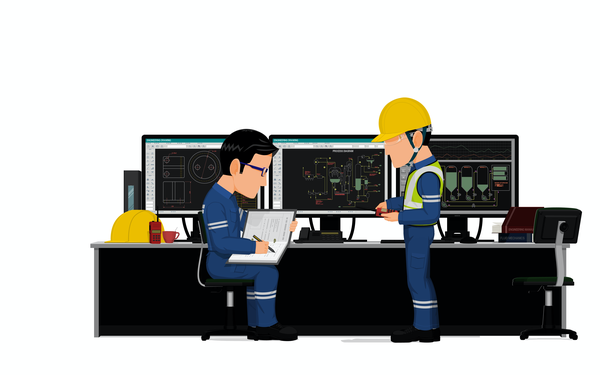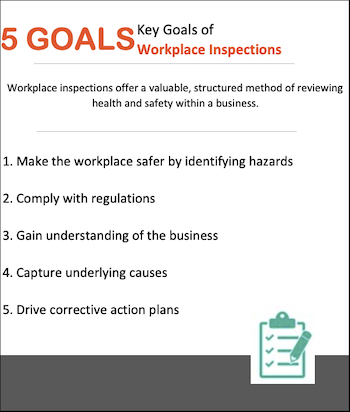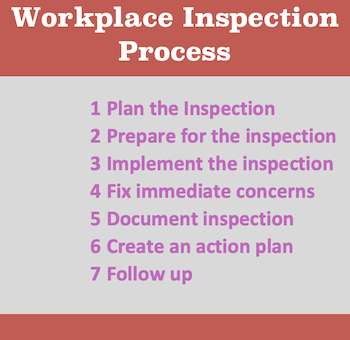
Workplace inspections are focused activities within a business that target reducing hazards, incidents, and injuries by assessing things like working environments, equipment, and processes.
While often part of a broader continuous improvement initiative, they may also address legislative requirements.
In this article, we’ll be exploring the purpose of workplace inspections; we’ll explore:
- What is a workplace inspection
- Why should you carry out a workplace inspection?
- Workplace inspection goals
- When do workplace inspections occur?
- What is the workplace inspection process?
- Who is involved in workplace inspections?
- What are the benefits of a workplace inspection?
- What are the issues with workplace inspections?
What is a workplace inspection?
As described in our introduction, a workplace inspection is a pre-planned activity where the workplace is inspected to identify and record hazards or associated concerns.
Once identified, the hazards can then be addressed and remedied.
The impact of workplace inspections is to minimize the occurrence of injuries and incidents while complying with legislative obligations.
Why should you carry out a workplace inspection?
As we described above, inspections may involve identifying unsafe situations, working conditions, and processes.
As a result, workplace inspections offer a valuable, structured method of reviewing health and safety within a business.
There are several key reasons why workplace inspections are important:
- They make your workplace safer by identifying hazards that could result in serious incidents (such as injury, death).
- They help contribute towards industry compliance
- They are part of a continuous improvement cycle
- They can help assess previous inspections, ensuring hazards have been mitigated.
- They offer a method of engaging with the business, capturing issues and concerns from the workforce
- They can help an organizations leadership better understand jobs and tasks
- They offer a mechanism to review control processes
Workplace Inspection Goals

Now let’s look at some of these goals in more detail.
1/ They make your workplace safer by identifying hazards
Workplace inspections can help make working environments safe through the identification of hazards.
This is achieved by:
1/ Using experience and historical data to help inform where hazards may occur.
2/ Interaction with the workforce to identify unsafe practices
3/ Reviewing in situ where processes take place.
Without inspections, it may be difficult to identify or report on hazards leading to injury or incident.
2/ Workplace inspections and regulatory compliance
Most businesses are subject to health and safety regulations to which they must comply (examples include HSE in the UK, OSHA in the US, etc.). These usually mandate a requirement for some level of audit/inspection.
Carrying out voluntary inspections helps meet this requirement and demonstrates the level of priority that your organization bestows on safety.
If you are verifying safety yourself, then not only will you please regulators, but you’re also far more likely to spot non-compliance ahead of formal external audits.
3/ Gain further understanding of the business (jobs & tasks)
In order to have appropriate processes and policies, there must be a level of understanding about what’s actually going on within the business.
Internal reviews are an excellent method of gaining an understanding of what’s actually happening. Workplace inspections, by their very nature, require some level of interaction with workers. This can help inform and educate the team into shaping attributes such as policies, processes, equipment, and tools.
4/ Capture underlying causes.
Hazards, of course, don’t just occur by themselves; they all have a root cause.
Inspections help identify causes that can help in future reviews (helping to inform what to look for).
Examples of common causes include:
- Untidy or poorly laid out work areas (for example, excessive use of high storage areas in warehouse locations that could result in lifting injuries)
- Equipment not maintained
- Staff not trained (or training out of date)
- Poorly maintained work area (i.e., uneven flooring which might cause trips)
5/ Inspections drive corrective action plans
Once hazards have been identified, then the next step within the process is to implement corrective action.
Corrective action is ascertaining the hazard/issues cause and taking suitable steps to remedy them.
Given the nature of hazards, this root cause may not at first be obvious and may require further analysis (or use of tools such as “5 Why” or other).
Once an action plan has been implemented, it’s important to follow up. It’s a mistake to simply walk away (believing the job done); the next step is to monitor the improvement to ensure that it meets the desired result.
Your fix might utilize various tools, such as updating policies and procedures or changing working environments.
When do workplace inspections occur?
Most businesses will have a routine (often established via a process or policy) that dictates the frequency of inspections. These may include daily, weekly, monthly routines with specific areas of focus (or engagement with specific personnel).
Where an incident has occurred, there is likely to be a workplace inspection (often conducted by senior members of staff). Such post-incident inspections are by their nature ad-hoc, and those attending may vary depending on the severity.
What is the workplace inspection process?

While the process may vary subtly between businesses and industry – there is usually five key steps of the process, which are:
- Planning the inspection – this usually involves an element of identifying areas for inspection, scheduling, aligning resources to carry out the inspection.
- Preparing for the inspection – this step typically includes preparing any materials required for the inspection, discussing the inspection with the team who will carry out the inspection (this may include workers who will be around during the inspection process), preparing any key documentation that will be used.
- Implementing the inspection – this step involves carrying out the inspection.
- Rectifying any immediate concerns
- Documenting the inspection – this step usually involves completing company documentation that captures the event, including:
- The area surveyed
- Who was involved
- Issues captured
- Target dates for follow up’s
- Following up post-inspection – This step will involve following up actions to ensure they have been closed and any staff engagement required.
Who is involved in workplace inspections?
While anyone can carry out workplace inspections, there are usually processes and policies within a business that dictate the formal process where specific people have responsibilities.
Those undertaking the review is usually divided into two groups:
- People internal to the organization
- People external to the organization.
People internal to the organization who may conduct workplace inspections may include
- Designated personnel responsible for conducting inspections
- A health and safety officer within the company
- Someone with a level of accountability/responsibility, such as a line manager (who has undergone appropriate training).
In some circumstances, individuals external to the organization may also carry out inspections; these could include
- Consultants who specialize in workplace inspections
- Union representatives
- Individuals from a government body (such as the HSE)
- Customers
What are the benefits of a workplace inspection?
From the article above, you can hopefully see that the benefits to performing workplace inspections are fairly obvious, they help:
- Reduce Incidents and Accidents
- Identify potential concerns
- Meet regulatory compliance
- Engage the workforce
- Identify processes that are not performing as inspected
What are the issues with workplace inspections?
As with any process, there are some things to watch out for; these include:
- Poorly trained staff (or those lacking experience) carrying out inspections – this may result in hazards being missed.
- Infrequent review cycle – this allows hazards to build up without being caught.
- Actions not followed up – leaving potential hazards still a risk
- Failure to focus across the business – e.g., focus on the production area, ignoring office areas.
- Lack of resources to carry out inspections
Summary
When reviewing hazards, workplace inspections can deliver real benefits.
Having a standardized process of inspection with suitably qualified personnel (who engage directly with the workforce) is the way to go.
As ever, we’d love to hear your thoughts; perhaps you administer the workplace inspections in your organization? Perhaps you have some lessons learned that you’d like to share?
We’d love to hear from you.
You can reach us on Twitter or via the comments section below.
